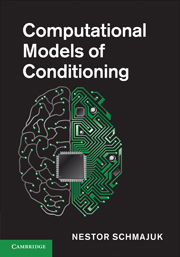Book contents
- Frontmatter
- Contents
- List of contributors
- Introduction
- 1 Evolution of attention in learning
- 2 The arguments of associations
- 3 The hybrid modeling approach to conditioning
- 4 Within-compound associations: models and data
- 5 Associative modulation of US processing: implications for understanding of habituation
- 6 Attention, associations, and configurations in conditioning
- 7 Computer simulation of the cerebellum
- 8 The operant/respondent distinction: a computational neural-network analysis
- Index
- References
3 - The hybrid modeling approach to conditioning
Published online by Cambridge University Press: 10 January 2011
- Frontmatter
- Contents
- List of contributors
- Introduction
- 1 Evolution of attention in learning
- 2 The arguments of associations
- 3 The hybrid modeling approach to conditioning
- 4 Within-compound associations: models and data
- 5 Associative modulation of US processing: implications for understanding of habituation
- 6 Attention, associations, and configurations in conditioning
- 7 Computer simulation of the cerebellum
- 8 The operant/respondent distinction: a computational neural-network analysis
- Index
- References
Summary
Abstract
Broadly, models of conditioning and associative learning have two main goals: (1) to describe the way in which stimuli are represented in the learning system (see Harris, 2010, this volume), and (2) to describe the mechanics of the learning process itself, that is to say, the factors that determine the amount of learning that a given stimulus will undergo on a given learning episode. Clearly these two issues are not perfectly separable: as Harris demonstrates, the nature of stimulus representation used by a learning system can influence the type of associative process that must be assumed in order for that system to learn in a similar manner to animals or humans. Nevertheless, the focus of the current chapter will be almost exclusively on the second of these issues. More specifically, this chapter will consider the various ways in which an organism's prior experience of stimuli, and prior learning about their consequences (the “associative history” of those stimuli), influences the amount that the organism will learn about those stimuli in future.
Over a century's worth of research on animal conditioning has generated a wealth of empirical evidence relating to the influence of associative history on future learning. Historically, in developing models of learning, theorists have tended to concentrate on one such influence and build a model centered on that aspect. For example (and to anticipate), the model developed by Mackintosh (1975) deals exclusively with examples of positive transfer of the processing of cues; Pearce and Hall's (1980) model was developed purely on the basis of examples of negative transfer of cue processing; and Rescorla and Wagner's (1972) model deals with competition between cues on the basis of the surprisingness of the outcome.
- Type
- Chapter
- Information
- Computational Models of Conditioning , pp. 71 - 107Publisher: Cambridge University PressPrint publication year: 2010
References
- 8
- Cited by



